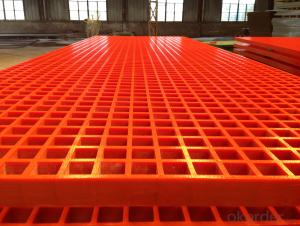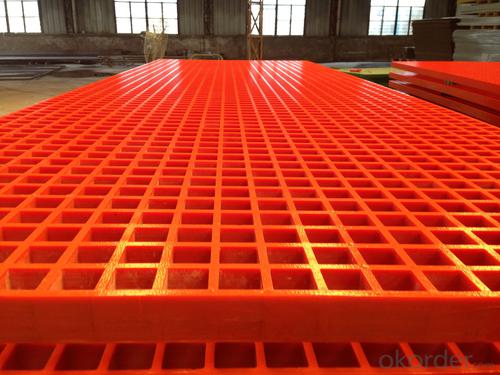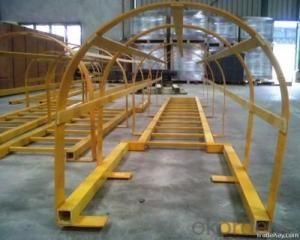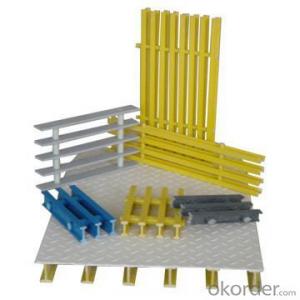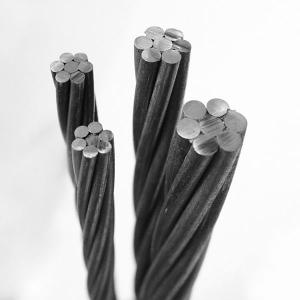FRP grating for pollution discharge construcation
- Loading Port:
- Tianjin
- Payment Terms:
- TT OR LC
- Min Order Qty:
- 1000 m²
- Supply Capability:
- 10000000 m²/month
OKorder Service Pledge
OKorder Financial Service
You Might Also Like
Specifications of FRP grating
- Meet ASTM E-84 AND ISO9001
- Anti-corrosion floor
- Anti-conductive
- Walkway,platform,trench cover,fence,stair treads
- Surface treatment
- Concave,grit,smooth,covered
- Many colors can be chose: Red,yellow,grey,blue and other RAL colors
Common product specifications:
L×W×H(mm×mm×mm) | Center Distance(mm×mm) | Tendons relief(mm) | Module(mm) |
1220×3660×38 | 38.1×38.1 | 7 | 38.5-41 |
1220×3660×30 | 38.1×38.1 | 7 | 30.5-32 |
1220×3660×25 | 38.1×38.1 | 6.8 | 25.5-27 |
1220×3660×50 | 50.7×50.7 | 7.5 | 50.5-52 |
1000×4038×38 | 38.1×38.1 | 7 | 38.5-41 |
1000×4038×25 | 38.1×38.1 | 6.8 | 25.5-27 |
Features of FRP Grating:
- Corrosion and Chemical resistant
- Slip-resistant
- High strength-to-weight ratio
- Ergonomic
- Low maintenance
- Fire retardant
- Easily fabricated and installed
Other positive features:
Electrically and thermally non-conductive
Ultra-violet resistant
Provided in a number of grating thickness and panel sizes with many types of mesh size
Offers bi-directional strength characteristic
Impact resistance
Electronically transparent
As FRP grating has so many excellent features,so now FRP grating are widely used in many fields.
Drilling platform,walkway,water treatment plant,car wash and so on.
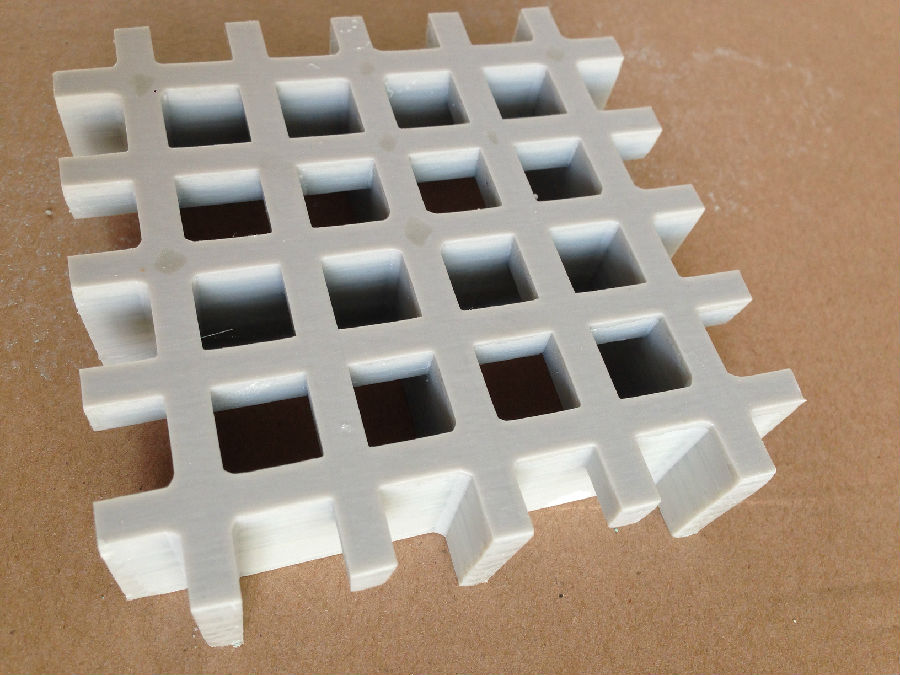

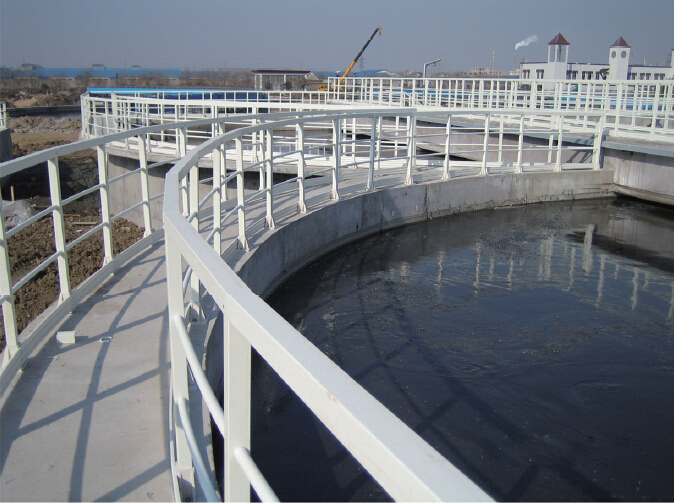
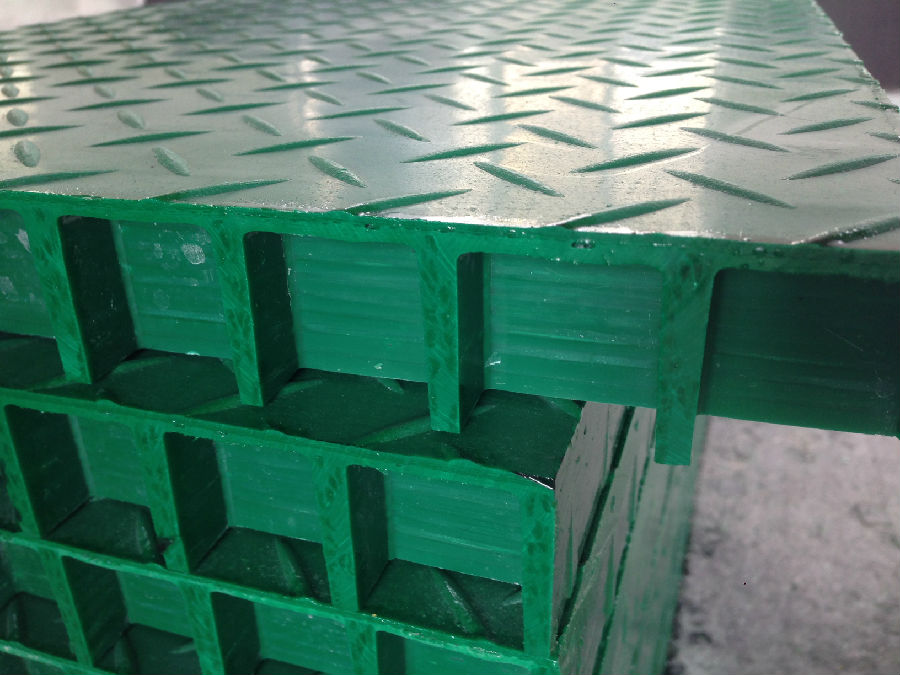

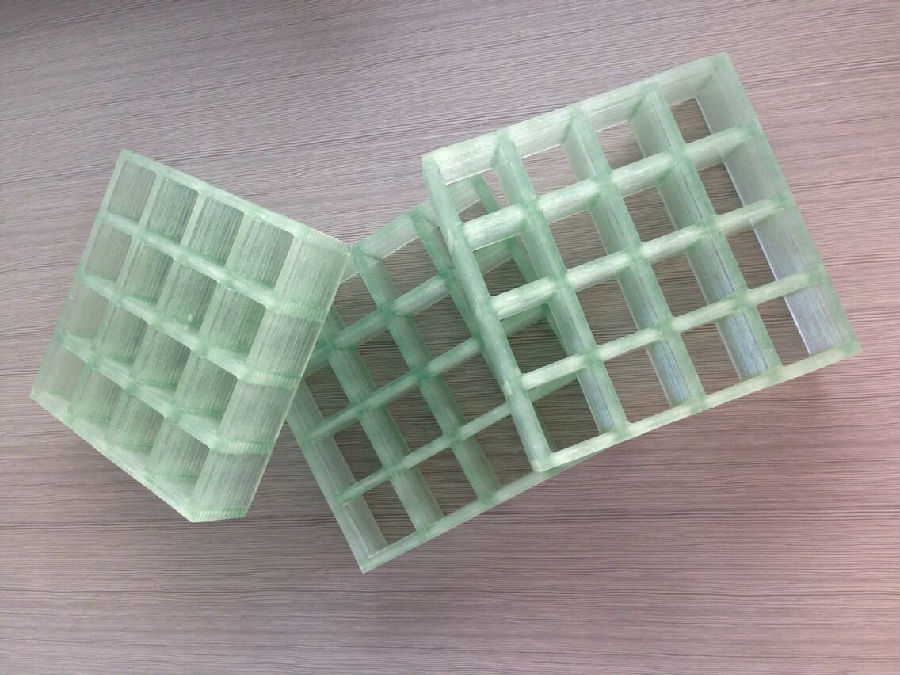
- Q:Can FRP pultrusion profiles be used in the construction of conveyor systems?
- Yes, FRP (Fiber Reinforced Polymer) pultrusion profiles can be effectively used in the construction of conveyor systems. FRP pultrusion profiles offer several advantages that make them suitable for such applications. Firstly, FRP pultrusion profiles are lightweight yet strong, making them ideal for conveyor system construction. Their high strength-to-weight ratio allows for easy installation and maintenance, reducing the overall weight of the system while maintaining structural integrity. This feature is particularly beneficial when designing and building long-span conveyor systems. Secondly, FRP pultrusion profiles are highly corrosion-resistant. Unlike traditional materials like steel or aluminum, FRP pultrusions are resistant to rust, chemicals, and moisture. This resistance makes them suitable for conveyor systems that may be exposed to harsh environments or corrosive substances, such as in mining or chemical industries. Another advantage of FRP pultrusion profiles is their electrical insulation properties. They do not conduct electricity, which is a crucial requirement in conveyor systems where electrical components are present. This property ensures a higher level of safety and reduces the risk of electrical hazards. Furthermore, FRP pultrusion profiles can be easily customized to meet specific design requirements. They can be manufactured in various shapes and sizes, allowing for flexibility in conveyor system design. Additionally, FRP profiles can incorporate features such as channels, slots, or reinforcements, which can be advantageous for mounting accessories or facilitating the movement of goods on the conveyor. Lastly, FRP pultrusion profiles are durable and have a long service life. They are resistant to UV degradation and do not require frequent maintenance or painting, reducing lifecycle costs compared to traditional materials. This durability makes them a cost-effective choice for conveyor system construction. In conclusion, FRP pultrusion profiles are an excellent choice for the construction of conveyor systems. Their lightweight, corrosion resistance, electrical insulation properties, customization options, and durability make them a reliable and efficient material for such applications.
- Q:Can FRP pultrusion profiles be used in the agricultural and farming industry?
- Yes, FRP pultrusion profiles can be used in the agricultural and farming industry. These profiles are lightweight, durable, and resistant to corrosion, making them suitable for various applications such as structural supports, fencing, gates, and equipment enclosures. They offer high strength-to-weight ratio, excellent weather resistance, and can withstand harsh environmental conditions commonly found in agricultural settings. Additionally, FRP profiles are non-conductive and have low thermal conductivity, which makes them ideal for electrical insulation and thermal management in farm equipment.
- Q:Are FRP pultrusion profiles resistant to moisture or humidity?
- Yes, FRP pultrusion profiles are highly resistant to moisture and humidity. The combination of fiberglass reinforcement and resin matrix used in their construction makes them non-corrosive and impervious to water absorption. This inherent resistance ensures their durability and performance in humid or moist environments without compromising their structural integrity.
- Q:How do FRP pultrusion profiles perform in seismic zones?
- FRP pultrusion profiles perform well in seismic zones due to their inherent lightweight and high-strength properties. These profiles have excellent resistance to earthquakes as they are designed to be flexible, which allows them to absorb and dissipate energy during seismic events. Additionally, FRP materials are non-corrosive, which makes them more durable in seismic zones compared to traditional construction materials.
- Q:Are FRP pultrusion profiles resistant to saltwater corrosion?
- Yes, FRP (Fiber Reinforced Plastic) pultrusion profiles are highly resistant to saltwater corrosion. The corrosion resistance of FRP profiles is one of their key advantages over traditional materials such as steel or aluminum. The combination of the reinforcing fibers and the resin matrix used in FRP pultrusion profiles makes them inherently resistant to the corrosive effects of saltwater. FRP profiles are composed of a mixture of glass or carbon fibers embedded in a thermosetting resin. These materials do not react with saltwater, preventing the corrosion that occurs in metals when exposed to saltwater for an extended period. Additionally, the resin matrix used in FRP profiles provides a protective barrier that further prevents saltwater from reaching the reinforcing fibers. The corrosion resistance of FRP pultrusion profiles makes them ideal for applications in marine environments. They are commonly used in structures such as seawalls, dock fenders, offshore platforms, and marine vessels. The durability of FRP profiles in saltwater environments ensures long-term performance and reduces the need for frequent maintenance or replacement. However, it is important to note that while FRP pultrusion profiles are highly resistant to saltwater corrosion, they may still be affected by other factors such as UV radiation or chemical exposure. Therefore, it is essential to consider the specific environmental conditions and consult with manufacturers or experts to select the most suitable FRP profile for a particular application.
- Q:What are the typical dimensions and sizes of FRP pultrusion profiles?
- The dimensions and sizes of FRP pultrusion profiles may vary depending on the application and manufacturer. However, there are some common ranges to consider. Concerning dimensions, the length of FRP pultrusion profiles can range from a few feet to several tens of feet, depending on the project requirements. The width or height of the profiles can vary greatly depending on the intended use, but typical dimensions usually fall within 0.5 inches to 12 inches. The size of FRP pultrusion profiles is determined by their cross-sectional area, usually measured in square inches. The cross-section can take on various shapes, such as rectangular, square, round, or custom designs. Typical sizes of FRP pultrusion profiles can range from as small as 0.1 square inches to as large as 100 square inches or more. It's worth noting that manufacturers can create custom-made FRP pultrusion profiles to meet specific project requirements. They have the flexibility to produce profiles with unique dimensions and sizes, ensuring they align with the specific needs of the application. Therefore, it's advisable to consult with the manufacturer or supplier to determine the most suitable dimensions and sizes for a specific FRP pultrusion profile.
- Q:Can FRP pultrusion profiles be used in the construction of railway platforms?
- Yes, FRP (Fiber Reinforced Polymer) pultrusion profiles can be used in the construction of railway platforms. FRP pultruded profiles offer several advantages that make them suitable for this application. Firstly, FRP pultrusion profiles are lightweight yet highly durable. This makes them ideal for railway platforms as they can withstand heavy loads and frequent foot traffic without experiencing significant deformation or degradation over time. Secondly, FRP pultruded profiles have excellent corrosion resistance. This is particularly important for railway platforms, which are often exposed to harsh environmental conditions, including rain, snow, and salt. Unlike traditional materials such as steel or wood, FRP does not rust or rot, ensuring a longer lifespan for the platform. Additionally, FRP pultrusion profiles offer design flexibility. They can be customized to meet specific dimensional and structural requirements, allowing for the creation of platforms of various shapes and sizes. This versatility is beneficial for railway platforms, as they often need to be tailored to fit the available space and accommodate specific railway configurations. Furthermore, FRP pultrusion profiles have good electrical insulation properties. This is important for railway platforms, as they need to be electrically isolated from the tracks to prevent electrical shocks and ensure passenger safety. Lastly, FRP pultrusion profiles are easy to install and require minimal maintenance. They can be prefabricated off-site and quickly assembled on-site, reducing construction time and costs. Moreover, FRP does not require regular painting or sealing, saving both time and money on maintenance. In conclusion, FRP pultrusion profiles are a viable option for the construction of railway platforms due to their lightweight, durability, corrosion resistance, design flexibility, electrical insulation properties, and ease of installation and maintenance.
- Q:Can FRP pultrusion profiles be used in the construction of outdoor signage?
- Yes, FRP (Fiber Reinforced Polymer) pultrusion profiles can be used in the construction of outdoor signage. FRP pultrusion profiles are known for their durability, strength, and resistance to various environmental conditions, making them suitable for outdoor applications. These profiles are typically made of a combination of fiberglass reinforcement and resin matrix, resulting in a lightweight yet strong material. Outdoor signage often needs to withstand harsh weather conditions, such as rain, sun exposure, and temperature fluctuations. FRP pultrusion profiles have excellent resistance to corrosion, UV rays, and moisture, ensuring that the signage can maintain its structural integrity and visual appeal over time. Furthermore, FRP pultrusion profiles can be customized to meet specific design requirements, allowing for flexibility in creating unique and eye-catching outdoor signage. These profiles can be easily shaped, cut, and assembled, making them a versatile choice for signage applications. In summary, FRP pultrusion profiles can indeed be used in the construction of outdoor signage due to their durability, resistance to environmental conditions, and flexibility in design.
- Q:Can FRP pultrusion profiles be used in the construction of safety barriers?
- Yes, FRP (Fiber Reinforced Polymer) pultrusion profiles can be effectively used in the construction of safety barriers. FRP pultrusion profiles offer several advantages over traditional materials like steel or concrete when it comes to safety barrier applications. Firstly, FRP pultrusion profiles are incredibly strong and durable. They have high tensile strength, which means they can withstand heavy loads and impacts without deforming or breaking. This makes them suitable for withstanding the forces that safety barriers may encounter, such as vehicular collisions or other accidents. Secondly, FRP pultrusion profiles are lightweight. Compared to steel or concrete, FRP is significantly lighter, making it easier to transport, install, and handle during construction. The lightweight nature of FRP also reduces the overall weight of the safety barrier structure, which can be an advantage in terms of ease of installation and cost-effectiveness. Additionally, FRP pultrusion profiles have excellent corrosion resistance. Unlike steel, FRP is not susceptible to rust or corrosion, which can compromise the integrity and safety of the barrier over time. This makes FRP an ideal material for safety barriers that are exposed to outdoor environments or harsh weather conditions. Furthermore, FRP pultrusion profiles are non-conductive and non-magnetic, which can be advantageous in certain safety barrier applications. For example, in areas where electrical or magnetic interference is a concern, such as near power lines or sensitive equipment, FRP barriers can provide an extra layer of safety by avoiding any potential electrical or magnetic hazards. Overall, FRP pultrusion profiles offer a reliable and efficient solution for constructing safety barriers. Their strength, durability, lightweight nature, corrosion resistance, and non-conductive properties make them a suitable choice for a wide range of safety barrier applications.
- Q:Can FRP pultrusion profiles be used in the aerospace industry?
- Yes, FRP (Fiber Reinforced Polymer) pultrusion profiles can be used in the aerospace industry. FRP materials offer several advantages that make them suitable for aerospace applications. Firstly, FRP profiles have high strength-to-weight ratios, which is crucial in the aerospace industry where weight reduction is a priority. Their lightweight nature allows for fuel efficiency and increased payload capacity. Secondly, FRP pultrusion profiles have excellent corrosion resistance, making them ideal for aerospace applications where exposure to harsh environments is common, such as high altitude, extreme temperatures, and moisture. This resistance to corrosion ensures the durability and longevity of the components, reducing maintenance and replacement costs. Additionally, FRP materials can be tailored to meet specific design requirements, enabling engineers to create complex shapes and structures with ease. This flexibility in design allows for enhanced performance and functionality in aerospace applications. Moreover, FRP pultrusion profiles exhibit excellent fatigue resistance, meaning they can withstand the cyclic loading and stress cycles that are common in aerospace operations. This characteristic ensures the reliability and safety of the components, which is of utmost importance in the aerospace industry. Furthermore, FRP materials offer electrical insulation properties, which can be advantageous in aerospace applications where electrical conductivity needs to be minimized or controlled. This insulation capability contributes to the overall safety and functionality of the components. In conclusion, FRP pultrusion profiles can indeed be used in the aerospace industry due to their high strength-to-weight ratios, corrosion resistance, flexibility in design, fatigue resistance, and electrical insulation properties. These qualities make FRP a viable and attractive choice for various aerospace applications, including aircraft structures, interior components, radomes, and others.
1. Manufacturer Overview |
|
|---|---|
| Location | |
| Year Established | |
| Annual Output Value | |
| Main Markets | |
| Company Certifications | |
2. Manufacturer Certificates |
|
|---|---|
| a) Certification Name | |
| Range | |
| Reference | |
| Validity Period | |
3. Manufacturer Capability |
|
|---|---|
| a)Trade Capacity | |
| Nearest Port | |
| Export Percentage | |
| No.of Employees in Trade Department | |
| Language Spoken: | |
| b)Factory Information | |
| Factory Size: | |
| No. of Production Lines | |
| Contract Manufacturing | |
| Product Price Range | |
Send your message to us
FRP grating for pollution discharge construcation
- Loading Port:
- Tianjin
- Payment Terms:
- TT OR LC
- Min Order Qty:
- 1000 m²
- Supply Capability:
- 10000000 m²/month
OKorder Service Pledge
OKorder Financial Service
Similar products
New products
Hot products
Hot Searches
Related keywords
